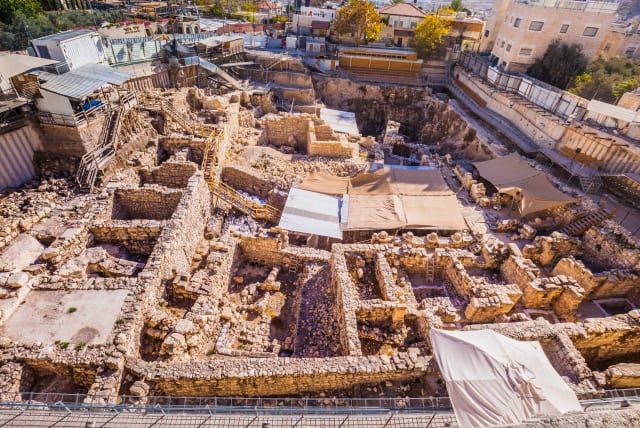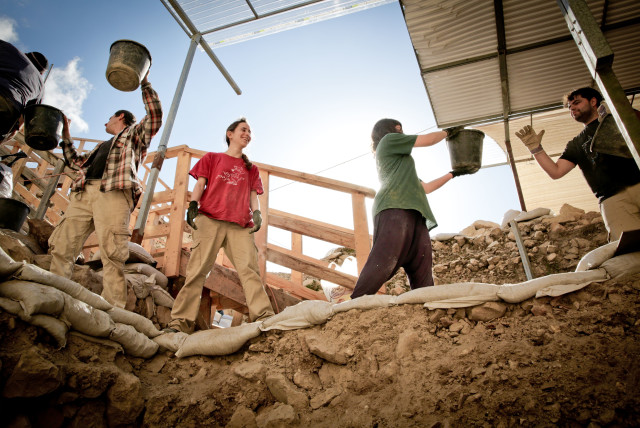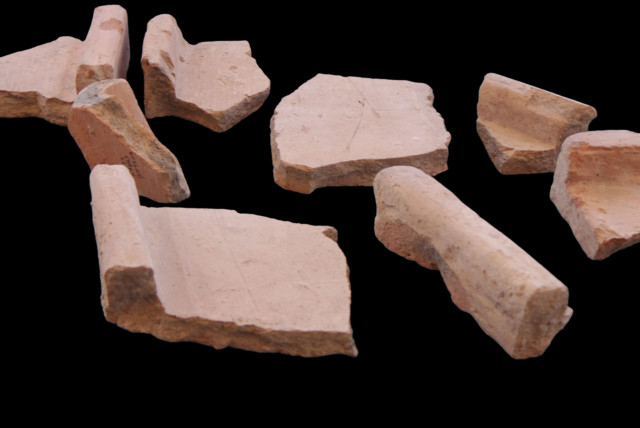Oldest ceramic rooftiles ever found in the Land of Israel

Ceramic tiles brought here at the time of the Greek Seleucid king Antiochus IV – of the Hanukkah story – have been discovered in the City of David.
In a discovery perfectly timed for Hanukkah, archaeologists and other scientists at the Israel Antiquities Authority (IAA) and Tel-Aviv University (TAU) have uncovered 16 of the oldest ceramic roofing tiles in the Land of Israel that provide a tangible connection with the story of the Festival of Lights. The findings were dated to the time of the Greek Seleucid King Antiochus IV.
The discovery was made at the City of David National Park, encircling the walls of the Old City of Jerusalem. Until now, little evidence of the Greek Seleucid presence has been discovered in Jerusalem.
Hanukkah means “dedication” in Hebrew. The holiday celebrates the rededication of Jerusalem’s Holy Temple in the second century BCE, when the land was run by the Seleucids (Syrian-Greeks) who tried to force the people of Israel to accept Greek culture and beliefs instead of Jewish observances and monotheistic belief.
The remains were dug up in the Giv‘ati Parking Lot Excavations funded by the City of David Foundation. Researchers, Dr. Yiftah Shalev and Dr. Filip Vukosavović from the IAA and TAU Prof. Yuval Gadot, remarked, “It is surprising how such a small discovery can open a tiny window into a vast world of research.”
A small band of faithful but poorly armed Jews, led by Judah the Maccabee defeated the mighty Seleucid army, reclaimed the Temple, and rededicated “the contaminated altar.” When they prepared to light the Temple’s candelabrum, they found a single jar of olive oil that had escaped contamination by the Greeks, supposed to only last one day. Miraculously, the supply of oil lasted for eight days, until new oil could be prepared under conditions of ritual purity.
The findings will be presented to the public at the Israel Antiquities Authority Conference (admission is free to the public), titled “In Those Days At This Time - The Hasmoneans are Coming,” which will take place on Monday, December 11.
Greek influence on ceramic roofing tiles
Ceramic roofing tiles were invented in Greece as early as the 7th Century BCE. Their durability and resistance to water, specifically rainwater and precipitation, made them popular in neighboring areas – but 500 years went by until they began to appear in the material culture of the Land of Israel.
It is possible that the person who brought them to Israel was none other than Antiochus IV Epiphanes – known to all of us from the story of Hanukkah. Representatives of the Seleucid King, Antiochus IV, who reigned over vast areas, from Syria to Persia, brought the knowledge and tradition of constructing tiled roofs from Seleucid-controlled Syria.
According to the story in the Book of the Maccabees, in 168 BCE, Antiochus IV undertook a military expedition to Jerusalem, which led to the outbreak of the Maccabean Revolt. To establish his control of the city, Antiochus constructed a mighty fortress that was known as the “Acra.”
The Greek soldiers residing in the fortress continued to rule the city after the Maccabean cleansing of the Jerusalem Temple. According to the descriptions in the books of the Maccabees and in the later writings of Flavius Josephus, the fortress embittered the lives of the Jewish residents in the city and the Temple. Despite several descriptions of the fortress in the Jewish and external literary sources, its exact location within the city has remained a puzzle that is debated by scholars.
According to Dr. Ayala Zilberstein of the IAA and TAU, “The architectural remains uncovered over recent years have reopened the debate, and they actually strengthen the identification of the fortress on the City of David hill. The discovery of the roof tiles constitutes additional evidence and further reinforcement from a different direction, for the identification of the Hellenistic presence in the City of David, characterized by foreign construction traditions.
Discovered architectural remains
Further research on many more tiles that were discovered in the previous archaeological expedition directed by the IAA’s Dr. Doron Ben-Ami and Dr. Yanna Tchekhanovets may shed more light on this issue.
"Tiles were very rare in our region during this period, and they were alien to local construction traditions, indicating that the technique of using tiles to roof parts of a tower or a structure inside that famous fortress was brought from Greek-controlled areas by foreign rulers.”
According to Vukosavović, “Until now, we had little material evidence for the presence of the Seleucid Greeks in Jerusalem. The new tiles discovered in the City of David provide tangible remains of the Seleucid Greek presence in the region, linking us with the story of Hanukkah. It’s very exciting to encounter the Seleucid ruler Antiochus IV ‘face-to-face’, almost 2,200 years after the events of Hanukkah.”
“The climate and the relatively low precipitation in Israel, as well as other factors, do not justify the use of tiles for roofing, yet Antiochus still chose to make use of these roof tiles, probably for cultural reasons and to make a statement, by introducing Greek monumental material culture in the country at a short distance from the Jewish Temple,” he continued. “It is therefore probably not incidental that with the collapse of Seleucid rule and the ascent of the Hasmoneans, roofing tiles disappear from Jerusalem, until the arrival of the new Roman conquerors.”
According to IAA director Eli Escuzido, “It is interesting to discover that roof tiles have been a standard roofing component throughout the world, although their design, shape, and size have evolved over the centuries; it's amazing how such an everyday item can teach us so much.”
The discovery will be exhibited to the public for the first time on Monday, the fifth night of Hanukkah, at the IAA conference that will take place between 15:00 and 18:00 at the Schottenstein National Campus for the Archaeology of Israel, near the Israel Museum. The free event is open to the public and will include a tour of the new National Campus. Details on the IAA’s Facebook pages.
Jerusalem Post Store
`; document.getElementById("linkPremium").innerHTML = cont; var divWithLink = document.getElementById("premium-link"); if (divWithLink !== null && divWithLink !== 'undefined') { divWithLink.style.border = "solid 1px #cb0f3e"; divWithLink.style.textAlign = "center"; divWithLink.style.marginBottom = "15px"; divWithLink.style.marginTop = "15px"; divWithLink.style.width = "100%"; divWithLink.style.backgroundColor = "#122952"; divWithLink.style.color = "#ffffff"; divWithLink.style.lineHeight = "1.5"; } } (function (v, i) { });


